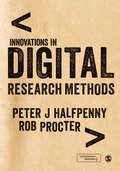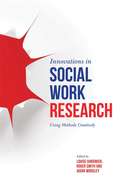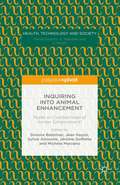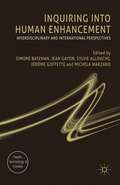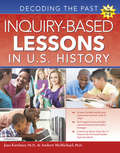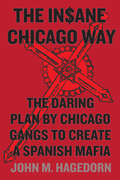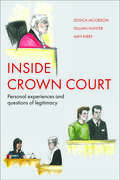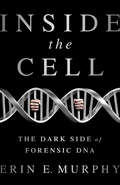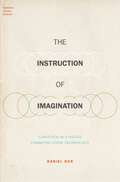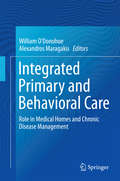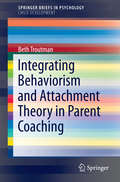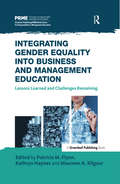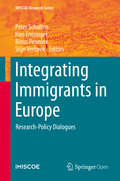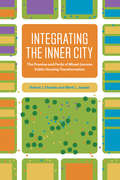- Table View
- List View
Innovations in Digital Research Methods
by Rob Procter Professor Peter HalfpennyVast amounts of digital data are now generated daily by people as they go about their lives, yet social researchers are struggling to exploit it. At the same time, the challenges faced by society in the 21st century are growing ever more complex, and demands research that is bigger in scale, more collaborative and multi-disciplinary than ever before. This cutting-edge volume provides an accessible introduction to innovative digital social research tools and methods that harness this ‘data deluge’ and successfully tackle key research challenges. Contributions from leading international researchers cover topics such as: Qualitative, quantitative and mixed methods research Data management Social media and social network analysis Modeling and simulation Survey methods Visualizing social data Ethics and e-research The future of social research in the digital age This vibrant introduction to innovative digital research methods is essential reading for anyone conducting social research today.
Innovations in Digital Research Methods (PDF)
by Rob Procter Professor Peter HalfpennyVast amounts of digital data are now generated daily by people as they go about their lives, yet social researchers are struggling to exploit it. At the same time, the challenges faced by society in the 21st century are growing ever more complex, and demands research that is bigger in scale, more collaborative and multi-disciplinary than ever before. This cutting-edge volume provides an accessible introduction to innovative digital social research tools and methods that harness this ‘data deluge’ and successfully tackle key research challenges. Contributions from leading international researchers cover topics such as: Qualitative, quantitative and mixed methods research Data management Social media and social network analysis Modeling and simulation Survey methods Visualizing social data Ethics and e-research The future of social research in the digital age This vibrant introduction to innovative digital research methods is essential reading for anyone conducting social research today.
Innovations in Social Work Research: Using Methods Creatively (PDF)
by Aidan Worsley Alastair Roy Becki Meakin Bogusia Temple Cherilyn Dance David Westlake Gina Barrett Harry Ferguson Helen Masson Jackie Robinson Jadwiga Leigh Jennifer Christensen Jennifer Taylor Jenny Hughes John Carpenter Josie Phillips Julian Manley Lena Dominelli Louise Hardwick Lynn Froggett Martin Elliott Mike Fisher Myles Balfe Natalie Robinson Nicolette Wade Pat Starkey Peter Beresford Roger Smith Sarah Banks Simon Hackett Sue Thompson Tricia Jessiman Trish O'Donnell Vic ForrestA valuable reference to help practising researchers not only to understand but also to apply innovative approaches to social work research. Featuring extended case studies of actual research projects, the book provides an overview of a number of central features and qualities of social work research. It incorporates both distinctive methodological features, such as approaches to participatory inquiry, and provides accounts of researcher strategies to address particular challenges, such as carrying out studies with hard to reach populations. This book combines important methodological insights with pragmatic guidance on commonly experienced problems and how these challenges can be overcome. This is a key resource for social work and social care students, social work practitioners and academics engaged in research.
Inquiring into Animal Enhancement: Model or Countermodel of Human Enhancement? (Health, Technology and Society)
by Jean Gayon Simone Bateman Sylvie Allouche Jérôme Goffette Michela MarzanoThis book explores issues raised by past and present practices of animal enhancement in terms of their means and their goals, clarifies conceptual issues and identifies lessons that can be learned about enhancement practices, as they concern both animals and humans.
Inquiring into Human Enhancement: Interdisciplinary and International Perspectives (Health, Technology and Society)
by Jean Gayon Sylvie Allouche Jérôme Goffette Michela MarzanoHuman enhancement has become a major concern in debates about the future of contemporary societies. This interdisciplinary book is devoted to clarifying the underlying ambiguities of these debates, and to proposing novel ways of exploring what human enhancement means and understanding what practices, goals and justifications it entails.
Inquiry-Based Lessons in U.S. History: Decoding the Past (Grades 5-8)
by Jana Kirchner Andrew McMichaelInquiry-Based Lessons in U.S. History: Decoding the Past provides primary source lessons that focus on teaching U.S. history through inquiry to middle school students. Students will be faced with a question to answer or problem to solve and will examine primary sources for evidence to create hypothetical solutions. The chapters focus on key chronological periods (e.g., the Age of Exploration to the Civil Rights era) and follow the scope and sequence of major social studies textbooks, with activities linked to the U.S. History Content Standards and the Common Core State Standards for Literacy in History/Social Studies. The three lesson plans in each chapter begin with an essential question that sets the focus for the primary sources and teaching strategies that follow. The lesson plans include differing types of primary sources such as photographs, speeches, political cartoons, historic maps, paintings, letters, and diary entries.Grades 5-8
Inquiry-Based Lessons in U.S. History: Decoding the Past (Grades 5-8)
by Jana Kirchner Andrew McMichaelInquiry-Based Lessons in U.S. History: Decoding the Past provides primary source lessons that focus on teaching U.S. history through inquiry to middle school students. Students will be faced with a question to answer or problem to solve and will examine primary sources for evidence to create hypothetical solutions. The chapters focus on key chronological periods (e.g., the Age of Exploration to the Civil Rights era) and follow the scope and sequence of major social studies textbooks, with activities linked to the U.S. History Content Standards and the Common Core State Standards for Literacy in History/Social Studies. The three lesson plans in each chapter begin with an essential question that sets the focus for the primary sources and teaching strategies that follow. The lesson plans include differing types of primary sources such as photographs, speeches, political cartoons, historic maps, paintings, letters, and diary entries.Grades 5-8
The Insane Chicago Way: The Daring Plan by Chicago Gangs to Create a Spanish Mafia
by John M. HagedornThe Insane Chicago Way is the untold story of a daring plan by Chicago gangs in the 1990s to create a Spanish Mafia—and why it failed. John M. Hagedorn traces how Chicago Latino gang leaders, following in Al Capone’s footsteps, built a sophisticated organization dedicated to organizing crime and reducing violence. His lively stories of extensive cross-neighborhood gang organization, tales of police/gang corruption, and discovery of covert gang connections to Chicago’s Mafia challenge conventional wisdom and offer lessons for the control of violence today. The book centers on the secret history of Spanish Growth & Development (SGD)—an organization of Latino gangs founded in 1989 and modeled on the Mafia’s nationwide Commission. It also tells a story within a story of the criminal exploits of the C-Note$, the “minor league” team of the Chicago’s Mafia (called the “Outfit”), which influenced the direction of SGD. Hagedorn’s tale is based on three years of interviews with an Outfit soldier as well as access to SGD’s constitution and other secret documents, which he supplements with interviews of key SGD leaders, court records, and newspaper accounts. The result is a stunning, heretofore unknown history of the grand ambitions of Chicago gang leaders that ultimately led to SGD’s shocking collapse in a pool of blood on the steps of a gang-organized peace conference. The Insane Chicago Way is a compelling history of the lives and deaths of Chicago gang leaders. At the same time it is a sociological tour de force that warns of the dangers of organized crime while arguing that today’s relative disorganization of gangs presents opportunities for intervention and reductions in violence.
The Insane Chicago Way: The Daring Plan by Chicago Gangs to Create a Spanish Mafia
by John M. HagedornThe Insane Chicago Way is the untold story of a daring plan by Chicago gangs in the 1990s to create a Spanish Mafia—and why it failed. John M. Hagedorn traces how Chicago Latino gang leaders, following in Al Capone’s footsteps, built a sophisticated organization dedicated to organizing crime and reducing violence. His lively stories of extensive cross-neighborhood gang organization, tales of police/gang corruption, and discovery of covert gang connections to Chicago’s Mafia challenge conventional wisdom and offer lessons for the control of violence today. The book centers on the secret history of Spanish Growth & Development (SGD)—an organization of Latino gangs founded in 1989 and modeled on the Mafia’s nationwide Commission. It also tells a story within a story of the criminal exploits of the C-Note$, the “minor league” team of the Chicago’s Mafia (called the “Outfit”), which influenced the direction of SGD. Hagedorn’s tale is based on three years of interviews with an Outfit soldier as well as access to SGD’s constitution and other secret documents, which he supplements with interviews of key SGD leaders, court records, and newspaper accounts. The result is a stunning, heretofore unknown history of the grand ambitions of Chicago gang leaders that ultimately led to SGD’s shocking collapse in a pool of blood on the steps of a gang-organized peace conference. The Insane Chicago Way is a compelling history of the lives and deaths of Chicago gang leaders. At the same time it is a sociological tour de force that warns of the dangers of organized crime while arguing that today’s relative disorganization of gangs presents opportunities for intervention and reductions in violence.
The Insane Chicago Way: The Daring Plan by Chicago Gangs to Create a Spanish Mafia
by John M. HagedornThe Insane Chicago Way is the untold story of a daring plan by Chicago gangs in the 1990s to create a Spanish Mafia—and why it failed. John M. Hagedorn traces how Chicago Latino gang leaders, following in Al Capone’s footsteps, built a sophisticated organization dedicated to organizing crime and reducing violence. His lively stories of extensive cross-neighborhood gang organization, tales of police/gang corruption, and discovery of covert gang connections to Chicago’s Mafia challenge conventional wisdom and offer lessons for the control of violence today. The book centers on the secret history of Spanish Growth & Development (SGD)—an organization of Latino gangs founded in 1989 and modeled on the Mafia’s nationwide Commission. It also tells a story within a story of the criminal exploits of the C-Note$, the “minor league” team of the Chicago’s Mafia (called the “Outfit”), which influenced the direction of SGD. Hagedorn’s tale is based on three years of interviews with an Outfit soldier as well as access to SGD’s constitution and other secret documents, which he supplements with interviews of key SGD leaders, court records, and newspaper accounts. The result is a stunning, heretofore unknown history of the grand ambitions of Chicago gang leaders that ultimately led to SGD’s shocking collapse in a pool of blood on the steps of a gang-organized peace conference. The Insane Chicago Way is a compelling history of the lives and deaths of Chicago gang leaders. At the same time it is a sociological tour de force that warns of the dangers of organized crime while arguing that today’s relative disorganization of gangs presents opportunities for intervention and reductions in violence.
The Insane Chicago Way: The Daring Plan by Chicago Gangs to Create a Spanish Mafia
by John M. HagedornThe Insane Chicago Way is the untold story of a daring plan by Chicago gangs in the 1990s to create a Spanish Mafia—and why it failed. John M. Hagedorn traces how Chicago Latino gang leaders, following in Al Capone’s footsteps, built a sophisticated organization dedicated to organizing crime and reducing violence. His lively stories of extensive cross-neighborhood gang organization, tales of police/gang corruption, and discovery of covert gang connections to Chicago’s Mafia challenge conventional wisdom and offer lessons for the control of violence today. The book centers on the secret history of Spanish Growth & Development (SGD)—an organization of Latino gangs founded in 1989 and modeled on the Mafia’s nationwide Commission. It also tells a story within a story of the criminal exploits of the C-Note$, the “minor league” team of the Chicago’s Mafia (called the “Outfit”), which influenced the direction of SGD. Hagedorn’s tale is based on three years of interviews with an Outfit soldier as well as access to SGD’s constitution and other secret documents, which he supplements with interviews of key SGD leaders, court records, and newspaper accounts. The result is a stunning, heretofore unknown history of the grand ambitions of Chicago gang leaders that ultimately led to SGD’s shocking collapse in a pool of blood on the steps of a gang-organized peace conference. The Insane Chicago Way is a compelling history of the lives and deaths of Chicago gang leaders. At the same time it is a sociological tour de force that warns of the dangers of organized crime while arguing that today’s relative disorganization of gangs presents opportunities for intervention and reductions in violence.
Inside Crown Court: Personal experiences and questions of legitimacy
by Jessica Jacobson Gillian HunterWith a new Foreword by David Ormerod of the Law Commission. Within the criminal justice system of England and Wales, the Crown Court is the arena in which serious criminal offences are prosecuted and sentenced. On the basis of up-to-date ethnographic research, this timely book provides a vivid description of what it is like to attend court as a victim, a witness or a defendant; the interplay between the different players in the courtroom; and the extent to which the court process is viewed as legitimate by those involved in it. This valuable addition to the field brings to life the range of issues involved and is aimed at students and scholars of criminal justice, policy-makers and practitioners, and interested members of the general public.
Inside the Cell: The Dark Side of Forensic DNA
by Erin E. MurphyJosiah Sutton was convicted of rape. He was five inches shorter and 65 pounds lighter than the suspect described by the victim, but at trial a lab analyst testified that his DNA was found at the crime scene. His case looked like many others-arrest, swab, match, conviction. But there was just one problem-Sutton was innocent.We think of DNA forensics as an infallible science that catches the bad guys and exonerates the innocent. But when the science goes rogue, it can lead to a gross miscarriage of justice. Erin Murphy exposes the dark side of forensic DNA testing: crime labs that receive little oversight and produce inconsistent results; prosecutors who push to test smaller and poorer-quality samples, inviting error and bias; law-enforcement officers who compile massive, unregulated, and racially skewed DNA databases; and industry lobbyists who push policies of "stop and spit.”DNA testing is rightly seen as a transformative technological breakthrough, but we should be wary of placing such a powerful weapon in the hands of the same broken criminal justice system that has produced mass incarceration, privileged government interests over personal privacy, and all too often enforced the law in a biased or unjust manner. Inside the Cell exposes the truth about forensic DNA, and shows us what it will take to harness the power of genetic identification in service of accuracy and fairness.
Inside the Cell: The Dark Side of Forensic DNA
by Erin E MurphyJosiah Sutton was convicted of rape. He was five inches shorter and 65 pounds lighter than the suspect described by the victim, but at trial a lab analyst testified that his DNA was found at the crime scene. His case looked like many others -- arrest, swab, match, conviction. But there was just one problem -- Sutton was innocent. We think of DNA forensics as an infallible science that catches the bad guys and exonerates the innocent. But when the science goes rogue, it can lead to a gross miscarriage of justice. Erin Murphy exposes the dark side of forensic DNA testing: crime labs that receive little oversight and produce inconsistent results; prosecutors who push to test smaller and poorer-quality samples, inviting error and bias; law-enforcement officers who compile massive, unregulated, and racially skewed DNA databases; and industry lobbyists who push policies of "stop and spit." DNA testing is rightly seen as a transformative technological breakthrough, but we should be wary of placing such a powerful weapon in the hands of the same broken criminal justice system that has produced mass incarceration, privileged government interests over personal privacy, and all too often enforced the law in a biased or unjust manner. Inside the Cell exposes the truth about forensic DNA, and shows us what it will take to harness the power of genetic identification in service of accuracy and fairness.
Institutional Arrangements for Conservation, Development and Tourism in Eastern and Southern Africa: A Dynamic Perspective
by René van der Duim Machiel Lamers Jakomijn Van WijkThis book presents an overview of different institutional arrangements for tourism, biodiversity conservation and rural poverty reduction in eastern and southern Africa. These approaches range from conservancies in Namibia, community-based organizations in Botswana, conservation enterprises in Kenya, private game reserves in South Africa, to sport hunting in Uganda and transfrontier conservation areas. The book presents a comparative analysis of these arrangements and highlights that most arrangements emerged in the 1990s through either a decentralized or centralized change trajectory that was sponsored by donors. They aim to address some of the challenges of the ‘fortress’ types of conservation by combining principles of community-based natural resource management with a neoliberal approach to conservation, evident in the use of tourism as the main mechanism for accruing benefits from wildlife. The book illustrates the empirical relevance of these novel arrangements by presenting their growth in numbers and discuss how these arrangements differ in their form. With respect to the conservation and development impacts of these arrangements, we show that they have secured large amounts of land for conservation, but also generated governance challenges and disputes on tourism benefit sharing, affecting the stability of these arrangements to generate socioeconomic and conservation benefits.
The Instruction of Imagination: Language as a Social Communication Technology (Foundations of Human Interaction)
by Dr. Daniel DorThe book suggests a new perspective on the essence of human language. This enormous achievement of our species is best characterized as a communication technology - not unlike the social media on the Net today - that was collectively invented by ancient humans for a very particular communicative function: the instruction of imagination. All other systems of communication in the biological world target the interlocutors' senses; language allows speakers to systematically instruct their interlocutors in the process of imagining the intended meaning - instead of directly experiencing it. This revolutionary function has changed human life forever, and in the book it operates as a unifying concept around which a new general theory of language gradually emerges. Dor identifies a set of fundamental problems in the linguistic sciences - the nature of words, the complexities of syntax, the interface between semantics and pragmatics, the causal relationship between language and thought, language processing, the dialectics of universality and variability, the intricacies of language and power, knowledge of language and its acquisition, the fragility of linguistic communication and the origins and evolution of language - and shows with respect to all of them how the theory provides fresh answers to the problems, resolves persistent difficulties in existing accounts, enhances the significance of empirical and theoretical achievements in the field, and identifies new directions for empirical research. The theory thus opens a new way towards the unification of the linguistic sciences, on both sides of the cognitive-social divide.
Integrated Primary and Behavioral Care: Role in Medical Homes and Chronic Disease Management
by William O'Donohue Alexandros MaragakisThis timely analysis spotlights the concepts and possibilities of the Patient-Centered Medical Home for bringing mental health and other specialties into primary care. Overview chapters present the Patient-Centered Medical Home model, emphasizing how such systems are organized to solve widespread problems with accessibility, affordability, efficiency, and safety. Practitioner roles, boundaries, and opportunities plus applications are clarified, as well as staffing, financial, and technological challenges. And the section on applications describe care models for special populations, such as comprehensive services to the seriously mentally ill and behavioral services to patients with chronic health conditions.Included in the coverage:Integrated care and specialty behavioral health care in the patient-centered medical home.Training the behavioral health workforce for the patient-centered medical home.The importance of stepped care protocols for the redesign of behavioral health care in patient-centered medical homes.Depression management in the medical home.Treating obesity in a primary care setting.Integrating behavioral health in the pediatric medical home.For health and clinical psychologists, primary care and family physicians, and public health professionals, Integrated Primary and Behavioral Care represents the potential for an exciting new frontier in primary care reform.
Integrating Behaviorism and Attachment Theory in Parent Coaching (SpringerBriefs in Psychology)
by Beth TroutmanThis practical guide provides a robust positive-parenting framework for professionals coaching parents of infants, toddlers, and primary school children. The first half of the book explains behaviorist and attachment theories of parenting, comparing, contrasting, and synthesizing them into an effective, research-informed approach to practice. The second half shows these guidelines in action, using play therapy as a means to improve disruptive child behaviors, correct harsh parenting practices, and address root causes of adversarial parent-child relationships. Throughout these chapters, vivid composite cases demonstrate not only common parent-child impasses but also therapist empathy, flexibility, and self-awareness. This innovative text:Makes a rigorous case for a combined behavioral/attachment approach to parent coaching.Reviews current data on behavioral and attachment-based parenting interventions.Details the use of an attachment-informed approach to providing behavioral interventions such as Parent-Child Interaction Therapy and Helping the Noncompliant Child.Illustrates how parent coaching can be tailored to match different patterns of attachment.Includes tools for evaluating coaching sessions.Integrating Behaviorism and Attachment Theory in Parent Coaching is an essential guide for professionals, graduate students, and researchers in clinical, child and school psychology, social work, pediatrics, mental health counseling, and nursing.
Integrating Gender Equality into Business and Management Education: Lessons Learned and Challenges Remaining
by Patricia M. Flynn Kathryn Haynes Maureen A. KilgourThis volume addresses the need to integrate gender equality into business and management education and provides examples of leading initiatives illustrating how this can occur from various disciplinary and global perspectives. Gender inequality has a long history in business schools and the workplace, and traditions are hard to change. Some disciplines remain resolutely gendered, affecting both women and men; and case materials on women leaders and managers are still rare.The chapters provide conceptual and research rationales as to why responsible management education must address the issue of gender equality. They also identify materials and resources to assist faculty in integrating gender issues and awareness into various disciplines and fields. These include specific case studies and innovations that assess or address the role of gender in various educational environments.The book is designed to help faculty integrate the topic of gender equality into their own teaching and research and gain support for the legitimacy of gender equality as an essential management education topic. This is the first book in a series on gender equality as a challenge for business and management education, published with the Principles of Responsible Management Education (PRME) Working Group on Gender Equality.
Integrating Gender Equality into Business and Management Education: Lessons Learned and Challenges Remaining
by Kathryn Haynes Patricia M. Flynn Maureen A. KilgourThis volume addresses the need to integrate gender equality into business and management education and provides examples of leading initiatives illustrating how this can occur from various disciplinary and global perspectives. Gender inequality has a long history in business schools and the workplace, and traditions are hard to change. Some disciplines remain resolutely gendered, affecting both women and men; and case materials on women leaders and managers are still rare.The chapters provide conceptual and research rationales as to why responsible management education must address the issue of gender equality. They also identify materials and resources to assist faculty in integrating gender issues and awareness into various disciplines and fields. These include specific case studies and innovations that assess or address the role of gender in various educational environments.The book is designed to help faculty integrate the topic of gender equality into their own teaching and research and gain support for the legitimacy of gender equality as an essential management education topic. This is the first book in a series on gender equality as a challenge for business and management education, published with the Principles of Responsible Management Education (PRME) Working Group on Gender Equality.
Integrating Immigrants in Europe: Research-Policy Dialogues (IMISCOE Research Series)
by Peter Scholten Han Entzinger Rinus Penninx Stijn VerbeekThis open access book explores how research and policymaking in the field of migrant integration have developed historically and how this interrelationship plays out in the strongly politicised climate of opinions on migration in Europe. It features interdisciplinary theoretical contributions as well as original empirical studies on research-policy dialogues at both the EU and country level.The chapters study not only how the dialogue between research and policy is structured (such as advisory bodies, research agencies, and ad-hoc committees), but also how these dialogues affect policymaking and the development of migrant integration research itself as well.The analysis reveals profound changes in the dialogue structures associated with the research-policy nexus in the domain of migrant integration. On the one hand, dialogue structures have become more ad-hoc, often established in response to distinct political events or to specific problems. On the other, politicisation has not thwarted all efforts to develop more institutionalised dialogue structures between producers and users of knowledge. In addition, research has contributed to policymaking in very different ways in various European countries.This edited volume is unique in this effort to reflect on the impact of research-policy dialogues both on the development of migrant integration policies as well as on migrant integration research. It will be of importance to scholars in this field as well as to policymakers and other stakeholders involved in migrant integration policymaking.
Integrating the Inner City: The Promise and Perils of Mixed-Income Public Housing Transformation
by Robert J. Chaskin Mark L. JosephFor many years Chicago’s looming large-scale housing projects defined the city, and their demolition and redevelopment—via the Chicago Housing Authority’s Plan for Transformation—has been perhaps the most startling change in the city’s urban landscape in the last twenty years. The Plan, which reflects a broader policy effort to remake public housing in cities across the country, seeks to deconcentrate poverty by transforming high-poverty public housing complexes into mixed-income developments and thereby integrating once-isolated public housing residents into the social and economic fabric of the city. But is the Plan an ambitious example of urban regeneration or a not-so-veiled effort at gentrification? In the most thorough examination of mixed-income public housing redevelopment to date, Robert J. Chaskin and Mark L. Joseph draw on five years of field research, in-depth interviews, and volumes of data to demonstrate that while considerable progress has been made in transforming the complexes physically, the integrationist goals of the policy have not been met. They provide a highly textured investigation into what it takes to design, finance, build, and populate a mixed-income development, and they illuminate the many challenges and limitations of the policy as a solution to urban poverty. Timely and relevant, Chaskin and Joseph’s findings raise concerns about the increased privatization of housing for the poor while providing a wide range of recommendations for a better way forward.
Integrating the Inner City: The Promise and Perils of Mixed-Income Public Housing Transformation
by Robert J. Chaskin Mark L. JosephFor many years Chicago’s looming large-scale housing projects defined the city, and their demolition and redevelopment—via the Chicago Housing Authority’s Plan for Transformation—has been perhaps the most startling change in the city’s urban landscape in the last twenty years. The Plan, which reflects a broader policy effort to remake public housing in cities across the country, seeks to deconcentrate poverty by transforming high-poverty public housing complexes into mixed-income developments and thereby integrating once-isolated public housing residents into the social and economic fabric of the city. But is the Plan an ambitious example of urban regeneration or a not-so-veiled effort at gentrification? In the most thorough examination of mixed-income public housing redevelopment to date, Robert J. Chaskin and Mark L. Joseph draw on five years of field research, in-depth interviews, and volumes of data to demonstrate that while considerable progress has been made in transforming the complexes physically, the integrationist goals of the policy have not been met. They provide a highly textured investigation into what it takes to design, finance, build, and populate a mixed-income development, and they illuminate the many challenges and limitations of the policy as a solution to urban poverty. Timely and relevant, Chaskin and Joseph’s findings raise concerns about the increased privatization of housing for the poor while providing a wide range of recommendations for a better way forward.
Integrating the Inner City: The Promise and Perils of Mixed-Income Public Housing Transformation
by Robert J. Chaskin Mark L. JosephFor many years Chicago’s looming large-scale housing projects defined the city, and their demolition and redevelopment—via the Chicago Housing Authority’s Plan for Transformation—has been perhaps the most startling change in the city’s urban landscape in the last twenty years. The Plan, which reflects a broader policy effort to remake public housing in cities across the country, seeks to deconcentrate poverty by transforming high-poverty public housing complexes into mixed-income developments and thereby integrating once-isolated public housing residents into the social and economic fabric of the city. But is the Plan an ambitious example of urban regeneration or a not-so-veiled effort at gentrification? In the most thorough examination of mixed-income public housing redevelopment to date, Robert J. Chaskin and Mark L. Joseph draw on five years of field research, in-depth interviews, and volumes of data to demonstrate that while considerable progress has been made in transforming the complexes physically, the integrationist goals of the policy have not been met. They provide a highly textured investigation into what it takes to design, finance, build, and populate a mixed-income development, and they illuminate the many challenges and limitations of the policy as a solution to urban poverty. Timely and relevant, Chaskin and Joseph’s findings raise concerns about the increased privatization of housing for the poor while providing a wide range of recommendations for a better way forward.
Integrating the Inner City: The Promise and Perils of Mixed-Income Public Housing Transformation
by Robert J. Chaskin Mark L. JosephFor many years Chicago’s looming large-scale housing projects defined the city, and their demolition and redevelopment—via the Chicago Housing Authority’s Plan for Transformation—has been perhaps the most startling change in the city’s urban landscape in the last twenty years. The Plan, which reflects a broader policy effort to remake public housing in cities across the country, seeks to deconcentrate poverty by transforming high-poverty public housing complexes into mixed-income developments and thereby integrating once-isolated public housing residents into the social and economic fabric of the city. But is the Plan an ambitious example of urban regeneration or a not-so-veiled effort at gentrification? In the most thorough examination of mixed-income public housing redevelopment to date, Robert J. Chaskin and Mark L. Joseph draw on five years of field research, in-depth interviews, and volumes of data to demonstrate that while considerable progress has been made in transforming the complexes physically, the integrationist goals of the policy have not been met. They provide a highly textured investigation into what it takes to design, finance, build, and populate a mixed-income development, and they illuminate the many challenges and limitations of the policy as a solution to urban poverty. Timely and relevant, Chaskin and Joseph’s findings raise concerns about the increased privatization of housing for the poor while providing a wide range of recommendations for a better way forward.
